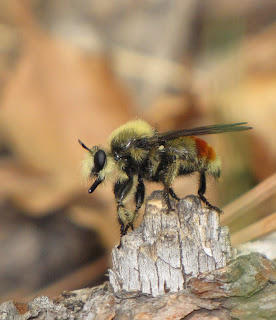It is, was, or will be termite swarming time across much of North America. Contrary to popular “knowledge,” we do have termites here in Colorado, at least below 7,000 feet elevation. Our most abundant species is the Arid-land Subterranean Termite, Reticulitermes tibialis. Back on the morning of May 24, I happened upon a colony that was liberating its “alates,” winged reproductive termites that will mate with members of other colonies and begin their own new colonies.
Subterranean termites actually nest in the soil, consuming wood and other sources of cellulose that are buried in the soil or in contact with the soil. Turning back a board out in the shortgrass prairie here in Colorado Springs is likely to uncover foraging termites that quickly seek shelter back in their underground tunnels.
A typical termite colony consists of a “king” and “queen,” a male and female pair that founded the colony and bond for life. That life can be a decade or more for the queen. Her sole mission is to lay eggs, and she is a bit of a bloated creature, her abdominal segments distended. Still, she can move around rather freely, in contrast to the huge, immobile queens of some tropical termite species that exist trapped in a “royal cell” defended by soldier termites.
Soldier termiteSubterranean termite colonies have soldiers, too, with large, rectangular heads and oversized jaws they can use to dispatch ants, the chief predators of termites. Most of the colony is made up of a “worker” caste that does the foraging, underground tunnel- and above-ground tube-construction, tends the queen and newly-minted immature termites. All the young termites in the colony are workers, but have the potential to become soldiers or reproductives. In situations where a queen dies, or becomes separated from part of the colony, some workers can metamorphose into supplementary reproductives capable of laying eggs themselves within their parent colony.
Once each year, a mature colony launches a swarm of winged male and female termites that goes in search of mates in hopes of starting new colonies. Arid-land Subterranean Termites typically swarm from January to March at elevations below 4,000 feet, and in June or July above that elevation. The alates I witnessed were issuing from imperceptible cracks in the soil, like toothpaste oozing from the tube. Check out the video below:
Termite swarms are like a buffet to insectivores, and it was only a matter of minutes before tiny ants set upon the lethargic alates, carting them off by the bushel to feed their own ant larvae in some subterranean nest. Birds, amphibians, lizards, spiders, and countless predatory insects feast on the living confetti.
Ant carrying off alate termiteThose female individuals that do survive are mostly wind-blown across the landscape, hoping to land in the vicinity of an unrelated colony that is also swarming. The female sheds her wings and emits a pheromone (chemical scent) that attracts males. Once a suitable mate appears, they mate and begin searching for a nesting site. The pair creates a small chamber underground or beneath a stone or other object, and she begins laying eggs.
Alate termite with hind wings stuck togetherHow do you tell winged termites from winged ants? Winged termites have two pairs of wings of equal length, whereas ants have the front wings much larger than the hind wings. Ants have long, elbowed antennae, while termites have shorter antennae with segments of equal length. Ants have the body clearly divided into three sections: head, thorax, and abdomen. Winged termites have those divisions much less obvious. The thorax and abdomen seem to merge seamlessly in termites.
Pair of winged ants, Crematogaster sp.Subterranean termites are not large insects. Even the alates of the Arid-land species measure only 10 millimeters from nose to wingtip. Soldiers are a mere 3.5-4.5 millimeters. This species occurs throughout the intermountain west of the U.S., eastward to Missouri, Arkansas, and Texas, south to Mexico. Other species of Reticulitermes range in other parts of North America.
A termite swarm outdoors, away from your own home, is a spectacle to behold. An indoor swarm….not so much. Still, to suddenly witness an enormous population of normally unseen animals erupting from the landscape is simply stunning. It helps to know that, in nature, termites are valuable decomposers that turn and aerate the soil while breaking down cellulose into nutrients now available to other living organisms.
Notes: Fairly recently (2007), termites became reclassified. Once they were members of their own order, the Isoptera. Today they are recognized essentially as “social cockroaches,” lumped with roaches in the order Blattodea.
Termites, unlike carpenter ants that merely chew cavities in wood to make nesting space, actually do eat wood. They can do this thanks to a gut fauna of microbes that efficiently break down cellulose. The bacteria, archaea, and protozoans exist only inside of termites, and are acquired by young termites when they consume fresh fecal material of adult termites, or are fed regurgitated, partially-digested food by worker termites.
Sources: Cranshaw, Whitney and Boris Kondratieff. 1995. Bagging Big Bugs. Golden, Colorado: Fulcrum Publishing. 324 pp.
Helfer, Jacques R. 1972. How to Know the Grasshoppers, Cockroaches, and Their Allies (2nd edition). Dubuque, Iowa: Wm. C. Brown Company Publishers. 359 pp.
Noll, Kenneth. “NSF Termite Project,” Noll Lab.
”Termites Are Cockroaches After All,” Natural History Museum (London) News.









































